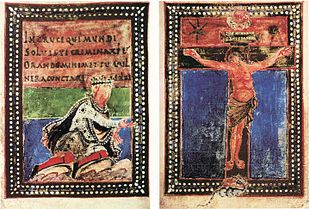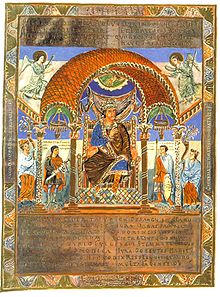Karl the bald




Karl II. (Born June 13, 823 in Frankfurt am Main ; † October 6, 877 in Avrieux near Modane ), also: Karl der Kahle (French: Charles II dit le Chauve, English Charles the Bald ), from the noble family of the Carolingians was King of West Franconia from 843 to 877 and King of Italy and Roman Emperor from 875 to 877 .
Life
origin
Karl was the youngest son of Ludwig the Pious from his second marriage to Judith . After the execution of Count Bernhard von Septimanien in 844, which was arranged by Karl, the suspicion arose that he had been killed for adultery with Karl's mother. Above all, Karl's rival brothers fueled the rumor that Karl might not be Ludwig's son at all, but the descendant of Bernhard from his relationship with Judith.
His upbringing by Walahfrid Strabo , who was called to the court of Charlemagne in Aachen , could not be confirmed.
His nickname the Bald could indicate that before the Reichstag in Worms 829, in contrast to his older brothers , Karl was not taken into account in the division of the Franconian Empire, so up to this point he was bald in the sense of landless / without possessions .
Domination
At the age of six, Karl was appointed dux Alemanniae in August 829 . As early as 838 he was crowned sub-king of Neustria (northern France). After the death of Emperor Ludwig in 840 and the victory over the eldest brother Lothar I in the Battle of Fontenoy in 841, together with Ludwig the German, the western third of the empire from the Pyrenees to the Scheldt fell to Charles in the Treaty of Verdun in 843 . A little later, the Treaty of Coulaines (November 843), which severely restricted his power, was imposed on him by his followers . In 848, after the deposition of his nephew Pippin II , he finally added direct rule over Aquitaine to the West Franconia that was thereby consolidated .
In 864 he issued the Edictum Pistense , in which, for the first time in Europe, it was legally stipulated which properties money coins had to have in order to be recognized as fit for payment.
After the death of Lothar II in 869, the ruler in the northern third of the Middle Kingdom divided by Lothar I in 855 , he tried to join the entire area to his western empire, but had to share it with his half-brother Ludwig the German in the Treaty of Meerssen in 870 .
The west of France was hit by Viking attacks several times during his reign . In 845 a large Viking fleet appeared before Paris, led by a certain Ragnar ; the Vikings only withdrew after paying a large sum of money. This was to be followed by further sieges by Vikings in 856, 865 and 866. Charles proved incapable of organizing an effective and sustainable defense, which during the time of his rule contributed to the decline of the political power of royalty and the rise of the high nobility.
After the death of his nephew Ludwig II of Italy, who had remained childless, in 875, he inherited his Italian kingdom, to which most of Burgundy belonged since the death of his nephew Charles of Provence in 863 . On December 25, 875 Charles was in Rome for the Roman emperor crowned.
He himself died in October 877 and was buried in Nantua , later reburied in the Saint-Denis basilica . When the royal tombs of Saint-Denis were sacked during the French Revolution , his tomb was opened and looted on October 18, 1793, and his remains were buried in a mass grave outside the church.
Karl's heirs were Ludwig the Stammler in western France and his East Franconian nephew Karlmann in Italy , eldest son of the East Franconian King Ludwig the German; In Burgundy, Boso von Vienne founded the Kingdom of Lower Burgundy in 879 .
progeny
Karl married twice:
- on December 14, 842 Irmentrud (825–869) in the Hasnon Abbey near Valenciennes , daughter of Count Odo von Orléans ( Geroldonen , Konradiner )
- on January 22, 870 Richildis of Provence († June 2, 910), daughter of Count Buvinus of Metz and the Richeut of Arles ( Buviniden ), sister of Boso of Vienne
He had nine children from Irmentrud:
- Judith (* probably 844; † after 870), ⚭ October 1, 856 Æthelwulf , King of Wessex , † 858; ⚭ II 858 King Aethelbald , King of Wessex, † 860, ⚭ III after a kidnapping in 862 at the end of 863 in Auxerre Balduin I , Count of Flanders , † 879
- Ludwig II the Stammler (846–879), King 877
- Charles the Child (847 / 848–866), King (of Aquitaine ) 855
- Karlmann († 876), 854 tonsure , 860 abbot of St. Médard in Soissons , 870 deposed, 873 blinded , 874 abbot of Echternach
- Lothar († 865 before December 25), 861 monk, later abbot of Saint-Germain d'Auxerre
- Ermentrud († after July 11, 877), abbess of Hasnon
- Hildegard
- Gisela
- Rotrud († after 889, probably after February 3, 912), probably abbess of Andlau
He had at least three children from Richildis:
- Rothild (* probably 871; † 928/929), ⚭ around 890 Count Roger of Maine († 900)
- uncertain: Drogo (* 872/873; † 873/874)
- uncertain: Pippin (* 872/873; † 873/874)
- a child (born March 23, 875; † soon after birth)
- Karl (October 10, 876; † before April 7, 877)
See also
literature
- Egon Boshof : Karl the Bald - novus Karolus magnus? In: Franz-Reiner Erkens (Ed.): Charlemagne and the legacy of cultures. Akademie-Verlag, Berlin 2001, ISBN 3-05-003581-1 , pp. 135–152.
- Irmgard Fees : Was Walahfrid Strabo the teacher and tutor of Charlemagne? In: Matthias Thumser , Annegret Wenz-Haubfleisch, Peter Wiegand (eds.): Studies on the history of the Middle Ages. Jürgen Petersohn on his 65th birthday. Theiss, Stuttgart 2000, ISBN 3-8062-1448-4 , pp. 42-61.
- Adelheid Krah: The emergence of the "potestas regia" in West Franconia during the first reign of Emperor Charles II (840–877). Akademie-Verlag, Berlin 2000, ISBN 3-05-003565-X .
- Janet L. Nelson : Charles the Bald. Longman, London 1992, ISBN 0-582-05585-7 .
- Pierre Riché : The Carolingians. dtv, Munich 1999, ISBN 3-423-04559-0 .
- Theodor Schieffer: Karl II. The bald. In: New German Biography (NDB). Volume 11, Duncker & Humblot, Berlin 1977, ISBN 3-428-00192-3 , pp. 175-181 ( digitized version ).
Web links
- Literature about Karl the Bald in the catalog of the German National Library
- The regests of Charlemagne
- Charles the Bald's prayer book - high-resolution digitized version in the bavarikon culture portal
Remarks
- ↑ Irmgard Fees: Was Walahfrid Strabo the teacher and educator of Charlemagne? In: Matthias Thumser. Annegret Wenz-Haubfleisch, Peter Wiegand (ed.): Studies on the history of the Middle Ages. Jürgen Petersohn on his 65th birthday. Theiss, Stuttgart 2000, ISBN 3-8062-1448-4 , pp. 42-61.
- ↑ "Edictum Pistense 864". In: Alfred Boretius, Victor Krause edd. MGH , capitularia regum Francorum, 2. Hanover 1897th
- ^ Descendants from the marriage with Richildis after Brigitte Kasten : Empresses in Carolingian times . In: Amalie Fößel (Ed.): The Empresses of the Middle Ages . Pustet, Regensburg 2011, ISBN 978-3-7917-2360-0 , pp. 11–34, here p. 24 .
| predecessor | Office | successor |
|---|---|---|
| Louis the Pious |
King of the west of France 843–877 |
Ludwig the Stammler |
| Pippin I. |
King of the Franks / Partial Kingdom of Aquitaine 838–845 |
Pippin ii |
| Ludwig II. |
King of Italy / King of the Lombards 875–877 |
Karlmann |
| Ludwig II. |
Roman emperor 875–877 |
Charlemagne |
| personal data | |
|---|---|
| SURNAME | Karl the bald |
| ALTERNATIVE NAMES | Charles II |
| BRIEF DESCRIPTION | West Franconian king (843–877) and emperor (875–877) |
| DATE OF BIRTH | June 13, 823 |
| PLACE OF BIRTH | Frankfurt am Main |
| DATE OF DEATH | October 6, 877 |
| Place of death | Avrieux |

